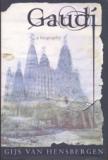God's Architect
Cities often express their unique character through the particular buildings with which they are associated. In the United States, for example, New York City is linked with either the Statue of Liberty or the Empire State Building, not to mention the recently disappeared twin towers of the World Trade Center; Washington, D.C., is connected with the Washington Monument, the Jefferson Memorial or the Lincoln Memorial, among many other historical commemorative sites; and San Francisco has its Golden Gate Bridge. Moreover, around the world, the Eiffel Tower symbolizes Paris, France; the Colosseum Rome, Italy; and the pyramids Cairo, Egypt. The same is true for Barcelona. Mention this city in northeastern Spain to the public at large and the architectural wonders of Antonio Gaudí come to mind, most noticeably his unfinished masterpiece, the Church of the Sagrada Família.
Antonio Gaudí (1852-1926) is one of Spain’s best known artists. The son of a coppersmith, he studied architecture in Barcelona and soon became one of the city’s leading architects at a time when Catalonia was experiencing a political and cultural renaissance as it became reacquainted with its unique roots within the Spanish landscapethe Renaixenca. Supported by influential patrons, Gaudí’s creations revealed a new architectural style in consonance with the dawning 20th-century’s desire for modernity. At the same time, they gave expression to Catalan nationalist concerns. In addition, religion played a significant role in the design of his buildings. First of all, the Catalan Roman Catholic Church was one of Gaudí’s most powerful patrons, comissioning him for some of his better known and best works, of which the unfinished Church of theSagrada Família is a culminating testimony. Second, Roman Catholicism was an integral element of the Catalan Renaixenca movement. Finally, as as a fervent Catholic, Gaudí wished to give tangible expression to spiritual concerns.
Despite his genius, Gaudí was not an easy man. Eccentric to the point of being theatrical, he attracted as well as antagonized his contemporaries. Whereas some considered him a mystic visionary, others saw him as a crazy religious fanatic. His buildings provoked the same intense reactions: they were either praised or detested precisely because of their modernity and individuality. The same intense response to the man and his work occurs today. On the one hand, there are those whose admiration for the architect from Reus, apart from praising his creative spirit and architectural innovations, goes so far as wanting to canonize him a saint of the Roman Catholic Church because of his devotional life and charitable concerns. On the other hand, there are those whose distaste for Gaudí leads them not only to criticize his architectural achievements, but to label the expressions of his ultraconservative Roman Catholicism those of a deranged religious fanatic.
One would think that such a controversial personality would inspire quite a number of biographies. However, although much has been written on Gaudí’s work, little has had to do with his life. The biographies written of him in Castilian and Catalan tend to be more hagiographical than scholarly. Unfortunately, there are no biographies in English. So the appearance of Gijs van Hensbergen’s Gaudí: A Biography is welcome.
Van Hensbergen, who lectures in architecture, is not new to Gaudí’s context, having published Art Deco and the travel book A Taste of Castille before his excursion into the life and work of the Catalan architect. The result is a readable yet informative scholarly biography, which not only recounts chronologically and in detail the life of Gaudí, but stops to analyze each of his works from an architect’s perspective, providing useful contextualizing narratives in Spanish history and culture to better understand the man and his work.
Gaudí: A Biography has the distinction of being at home both in the academic library and the popular bookstore. It is an attractively presented book, with both color and black-and-white illustrations of Gaudí’s works, as well as maps of Barcelona, Catalonia and Spain to serve as visual guides. These have the capacity to lure the tourist who has visited Barcelona and been familiarized with Gaudí’s creations, as well as the avid reader in search of new intellectual acquaintances. It is also attractive to the student of architecture, the Hispanist scholar, the cultural historian, the theologian and others. The detailed endnotes contain useful references; and the professional descriptions of Gaudí’s architectural achievementsnot to mention the man’s personality, particularly his religious intensityoffer ground for further exploration.
However, if one were to point out a flaw, it would be the writing. Despite its commercial and scholarly merits, the book lacks a fluid prose style. Van Hensbergen’s English, though readable, is often choppy, which leads one to believe that he is not comfortable writing in the language. Often, sentences marked by irregular punctuation do not smoothly flow one into another, and it seems as if he were translating from another language. But he is faithful to Catalan nomenclature, spelling and punctuation and provides helpful translations in English for both Castilian and Catalan words.
In addition, Van Hensbergen’s treatment of certain contextssuch as European decadent fin-de-siècle culture and the Spanish group of writers led by the philosopher-writer Miguel de Unamuno, who rallied around Spain’s defeat by the United States and became known as the Generation of 98is simplistic and one-sided. To be fair, however, a thorough treatment of these complex issues would have meant too much digression. Although Van Hensbergen’s perspective is far from objective, his narrative provides enough information for those interested in Gaudí’s architectural background.
Still, despite these objections, Gaudí is a commendable biography of a man whose modern vision did not exclude the transcendent. Readers will find in its pages food for thought, as buildings become places where we meet God.
This article also appeared in print, under the headline “God's Architect,” in the May 13, 2002, issue.








